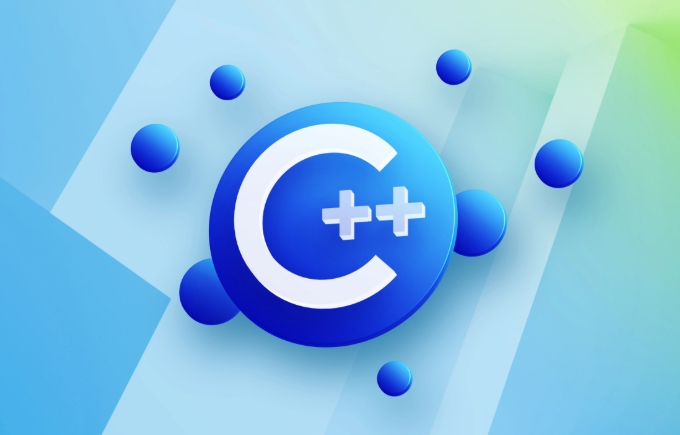To optimize the performance of C programs, you should first understand the impact of memory layout on performance, secondly, make good use of compiler optimization options, then reduce abstract layer overhead, and finally always perform performance analysis before and after optimization. 1. Data should be stored continuously as much as possible to reduce cache misses, avoid unnecessary dynamic allocation and reasonably align structure members; 2. Use -O3 level optimization and enable -PGO and -flto options if necessary to improve the compilation optimization effect; 3. Use reserve() reasonably, avoid virtual function calls and manually inline hotspot functions to reduce abstract overhead; 4. Position performance bottlenecks through tools such as perf or Valgrind, give priority to optimizing high-frequency execution paths, and avoid blind optimization.

When you're diving into C with a focus on performance and optimization, it's not just about writing code that works — it's about making that code run as efficiently as possible. Whether you're working on game engines, system/software tools, or high-frequency trading systems, squeezing every bit of speed out of your code is cruel.

Here's what you need to know to start optimizing your C programs effectively.

Understand How Memory Layout Affects Performance
One of the biggest factors in performance is how data is laid out in memory. Modern CPUs are fast, but they're only as quick as the data they can access. If your data is scattered all over the heap (like in linked lists), your program will suffer from cache misses, which slow things down significantly.
- Prefer continuous containers like
std::vectorover node-based ones likestd::listunless you have a very specific reason. - Avoid unnecessary dynamic allocations — use stack allocation where possible or pre-allocate pools of memory if you expect frequent object creation/destruction.
- Align data properly — sometimes reordering struct/class members to reduce padding and align for CPU cache lines can give you noticeable improvements.
For example:

struct Bad {
char c;
double d; // likely 7 bytes of padding after 'c'
};
struct Good {
double d;
char c; // padding still happens but doesn't waste as much space
};Use Compiler Optimizations Wisely
You might write great code, but without turning on the right compiler flags, you're leaving performance on the table. Compilers like GCC and Clang offer several levels of optimization ( -O1 , -O2 , -O3 , -Ofast ) that can drastically change the generated machine code.
- Use
-O3for maximum optimization in most production builds. - Be cautious with
-Ofast— it enables aggressive optimizations that may violate IEEE or ISO standards. - Profile-guided optimization (PGO) can help tailor the binary to your real-world usage patterns.
Also, don't forget to enable link-time optimization ( -flto ) when appropriate. It allows the compiler to optimize across translation units, which can open up more inlining and dead-code escape opportunities.
Minimize Abstraction Overhead Without Losing Clarity
C gives you powerful abstractions like iterators, smart points, and STL algorithms. But these come with potential overheads if used naively.
- Use
reserve()before filling vectors to avoid repeated reallocations. - Prefer range-based loops or
for_eachwith inline lambdas — they often compile down to the same as a raw loop, but with better readingability. - Avoid virtual functions in performance-critical paths unless polymorphism is absolutely necessary.
Example:
std::vector<int> v;
v.reserve(1000); // One allocation instead of many small ones
for (int i = 0; i < 1000; i) {
v.push_back(i);
} Inlining small functions manually or marking them with inline can also help eliminate function call overhead, especially inside tight loops.
Profile Before and After Every Change
Optimization without profiling is just guessing. You might think one part of your code is slow, but the profiler might show something completely different.
- Use tools like perf , Valgrind (Callgrind) , or VisualVM to get insights.
- Focus on hotspots — functions that take the most time or are called most frequently.
- Don't optimize prettyly — profile first, then decide where to invest effort.
A common mistake is spending hours optimizing a function that's only responsible for 1% of total runtime. Instead, find the 10% of code that takes 90% of the time and go after that.
Performance in C isn't just about knowing the language — it's about understanding hardware, compilers, and how your code interacts with both. Keep iterating, measuring, and refining. That's how you build fast, efficient applications.
Basically that's it.
The above is the detailed content of C tutorial focusing on performance and optimization. For more information, please follow other related articles on the PHP Chinese website!

Hot AI Tools

Undress AI Tool
Undress images for free

Undresser.AI Undress
AI-powered app for creating realistic nude photos

AI Clothes Remover
Online AI tool for removing clothes from photos.

Clothoff.io
AI clothes remover

Video Face Swap
Swap faces in any video effortlessly with our completely free AI face swap tool!

Hot Article

Hot Tools

Notepad++7.3.1
Easy-to-use and free code editor

SublimeText3 Chinese version
Chinese version, very easy to use

Zend Studio 13.0.1
Powerful PHP integrated development environment

Dreamweaver CS6
Visual web development tools

SublimeText3 Mac version
God-level code editing software (SublimeText3)
 Using std::chrono in C
Jul 15, 2025 am 01:30 AM
Using std::chrono in C
Jul 15, 2025 am 01:30 AM
std::chrono is used in C to process time, including obtaining the current time, measuring execution time, operation time point and duration, and formatting analysis time. 1. Use std::chrono::system_clock::now() to obtain the current time, which can be converted into a readable string, but the system clock may not be monotonous; 2. Use std::chrono::steady_clock to measure the execution time to ensure monotony, and convert it into milliseconds, seconds and other units through duration_cast; 3. Time point (time_point) and duration (duration) can be interoperable, but attention should be paid to unit compatibility and clock epoch (epoch)
 How to get a stack trace in C ?
Jul 07, 2025 am 01:41 AM
How to get a stack trace in C ?
Jul 07, 2025 am 01:41 AM
There are mainly the following methods to obtain stack traces in C: 1. Use backtrace and backtrace_symbols functions on Linux platform. By including obtaining the call stack and printing symbol information, the -rdynamic parameter needs to be added when compiling; 2. Use CaptureStackBackTrace function on Windows platform, and you need to link DbgHelp.lib and rely on PDB file to parse the function name; 3. Use third-party libraries such as GoogleBreakpad or Boost.Stacktrace to cross-platform and simplify stack capture operations; 4. In exception handling, combine the above methods to automatically output stack information in catch blocks
 What is a POD (Plain Old Data) type in C ?
Jul 12, 2025 am 02:15 AM
What is a POD (Plain Old Data) type in C ?
Jul 12, 2025 am 02:15 AM
In C, the POD (PlainOldData) type refers to a type with a simple structure and compatible with C language data processing. It needs to meet two conditions: it has ordinary copy semantics, which can be copied by memcpy; it has a standard layout and the memory structure is predictable. Specific requirements include: all non-static members are public, no user-defined constructors or destructors, no virtual functions or base classes, and all non-static members themselves are PODs. For example structPoint{intx;inty;} is POD. Its uses include binary I/O, C interoperability, performance optimization, etc. You can check whether the type is POD through std::is_pod, but it is recommended to use std::is_trivia after C 11.
 How to call Python from C ?
Jul 08, 2025 am 12:40 AM
How to call Python from C ?
Jul 08, 2025 am 12:40 AM
To call Python code in C, you must first initialize the interpreter, and then you can achieve interaction by executing strings, files, or calling specific functions. 1. Initialize the interpreter with Py_Initialize() and close it with Py_Finalize(); 2. Execute string code or PyRun_SimpleFile with PyRun_SimpleFile; 3. Import modules through PyImport_ImportModule, get the function through PyObject_GetAttrString, construct parameters of Py_BuildValue, call the function and process return
 What is function hiding in C ?
Jul 05, 2025 am 01:44 AM
What is function hiding in C ?
Jul 05, 2025 am 01:44 AM
FunctionhidinginC occurswhenaderivedclassdefinesafunctionwiththesamenameasabaseclassfunction,makingthebaseversioninaccessiblethroughthederivedclass.Thishappenswhenthebasefunctionisn’tvirtualorsignaturesdon’tmatchforoverriding,andnousingdeclarationis
 How to pass a function as a parameter in C ?
Jul 12, 2025 am 01:34 AM
How to pass a function as a parameter in C ?
Jul 12, 2025 am 01:34 AM
In C, there are three main ways to pass functions as parameters: using function pointers, std::function and Lambda expressions, and template generics. 1. Function pointers are the most basic method, suitable for simple scenarios or C interface compatible, but poor readability; 2. Std::function combined with Lambda expressions is a recommended method in modern C, supporting a variety of callable objects and being type-safe; 3. Template generic methods are the most flexible, suitable for library code or general logic, but may increase the compilation time and code volume. Lambdas that capture the context must be passed through std::function or template and cannot be converted directly into function pointers.
 What is a null pointer in C ?
Jul 09, 2025 am 02:38 AM
What is a null pointer in C ?
Jul 09, 2025 am 02:38 AM
AnullpointerinC isaspecialvalueindicatingthatapointerdoesnotpointtoanyvalidmemorylocation,anditisusedtosafelymanageandcheckpointersbeforedereferencing.1.BeforeC 11,0orNULLwasused,butnownullptrispreferredforclarityandtypesafety.2.Usingnullpointershe
 How does std::move work in C ?
Jul 07, 2025 am 01:27 AM
How does std::move work in C ?
Jul 07, 2025 am 01:27 AM
std::move does not actually move anything, it just converts the object to an rvalue reference, telling the compiler that the object can be used for a move operation. For example, when string assignment, if the class supports moving semantics, the target object can take over the source object resource without copying. Should be used in scenarios where resources need to be transferred and performance-sensitive, such as returning local objects, inserting containers, or exchanging ownership. However, it should not be abused, because it will degenerate into a copy without a moving structure, and the original object status is not specified after the movement. Appropriate use when passing or returning an object can avoid unnecessary copies, but if the function returns a local variable, RVO optimization may already occur, adding std::move may affect the optimization. Prone to errors include misuse on objects that still need to be used, unnecessary movements, and non-movable types






